Abstract
Medical education has long overlooked teaching the normal psychodynamics of everyday adult life (psychonormality) in favor of training in psychopathology. Proficiency in psychonormality skills (i.e., emotional competence) includes skilled management of internal emotions, external situations and relationships, and promotes patient satisfaction and healthcare outcomes as well as better mental health for practitioners. In particular, teaching psychonormality skills can be helpful to underrepresented minority (URM) students whose psychonormality experiences may differ from the culture of mainstream medical education. This paper outlines a clinically derived, pragmatic, five-step course designed to educate and train students for emotionally competent medical practice. A real-life example taken from an introductory workshop presentation of this course at a Student National Medical Association meeting is presented to illustrate the student-oriented application of the concepts. The enthusiastic reception accorded such workshops suggests an unmet need for this type of training in medical curricula. Benefits could include improved doctor-patient relationships and associated healthcare outcomes as well as higher retention of competent, professional, satisfied and healthier physicians, particularly URMs. Medical schools and residencies are encouraged to carefully evaluate the impact of incorporating psychonormality education and emotional competence training into their present curricula and faculty development.
Full text
PDF
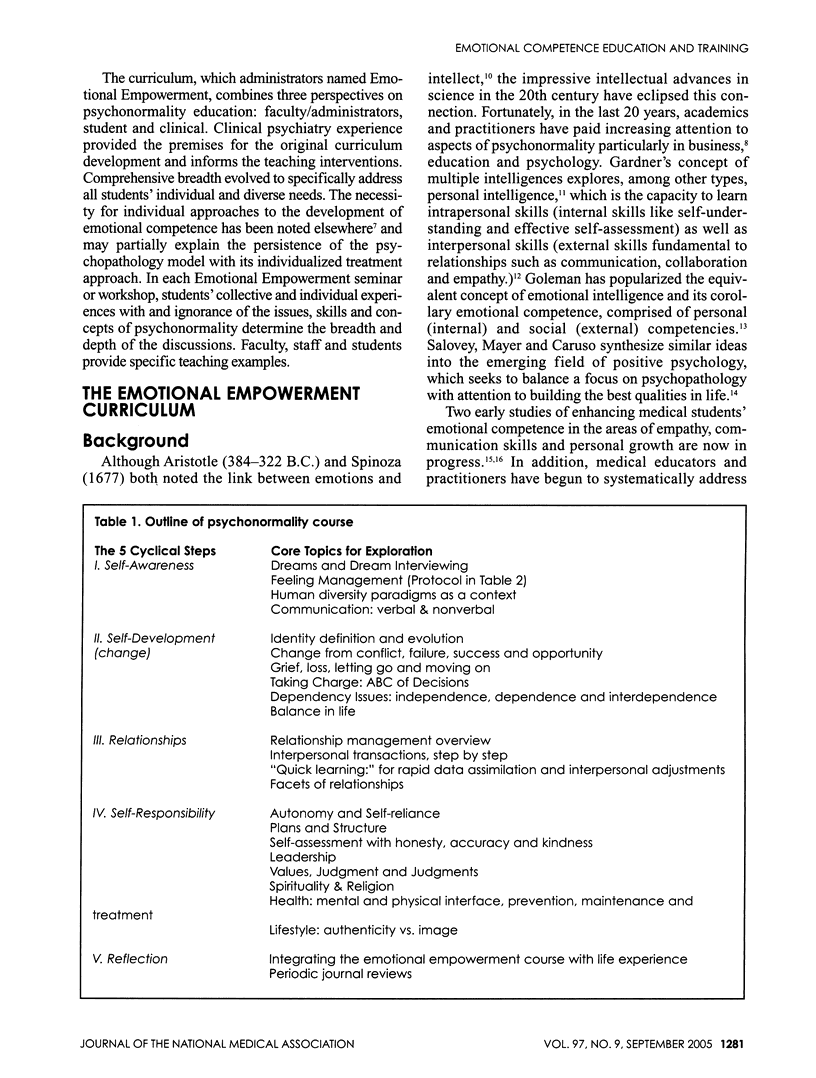
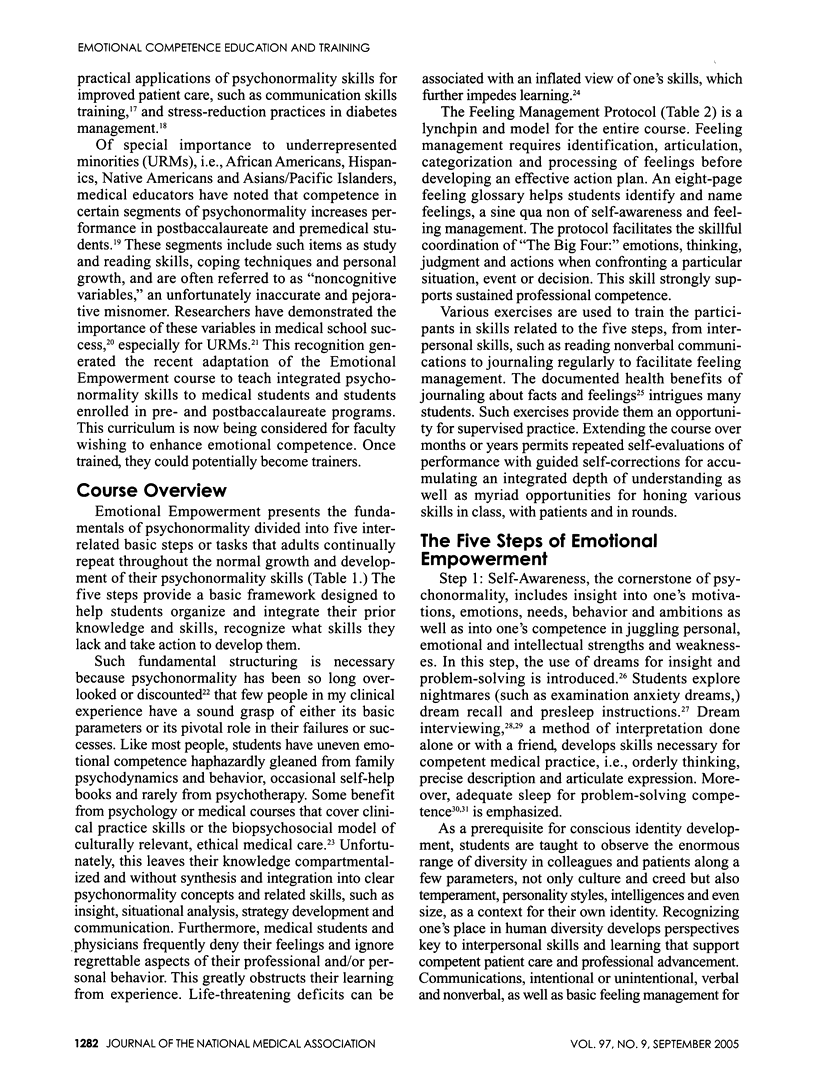
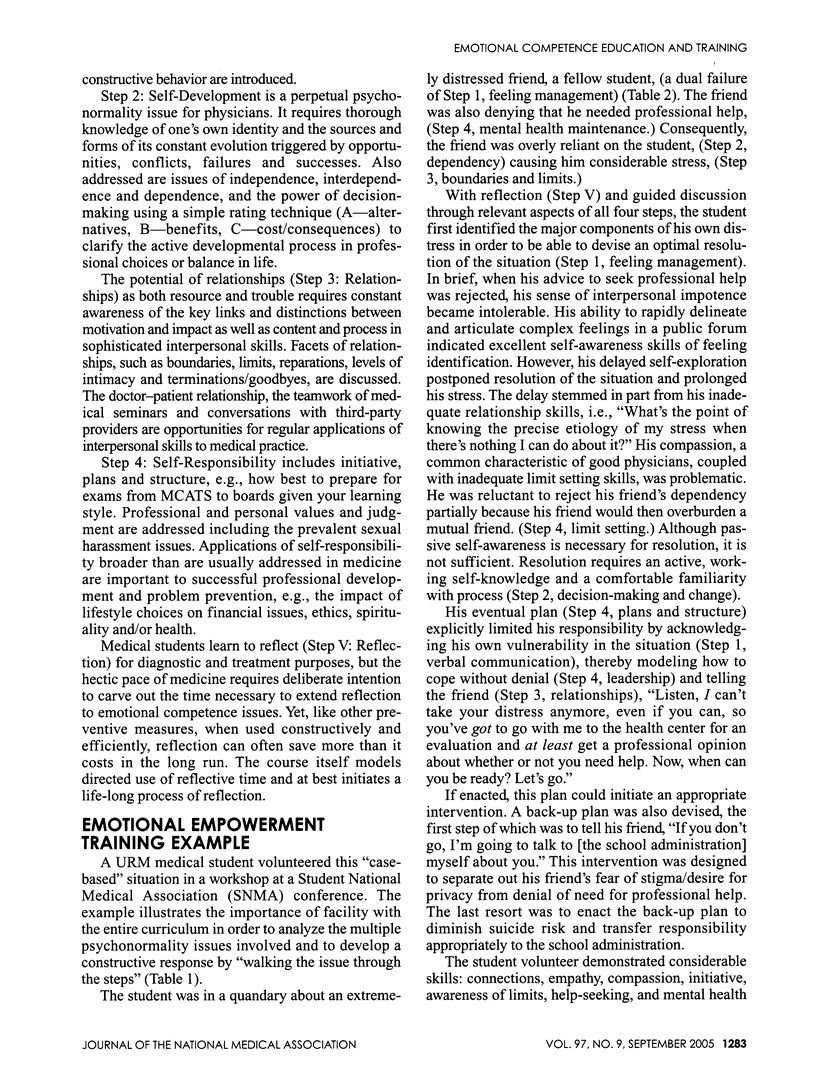

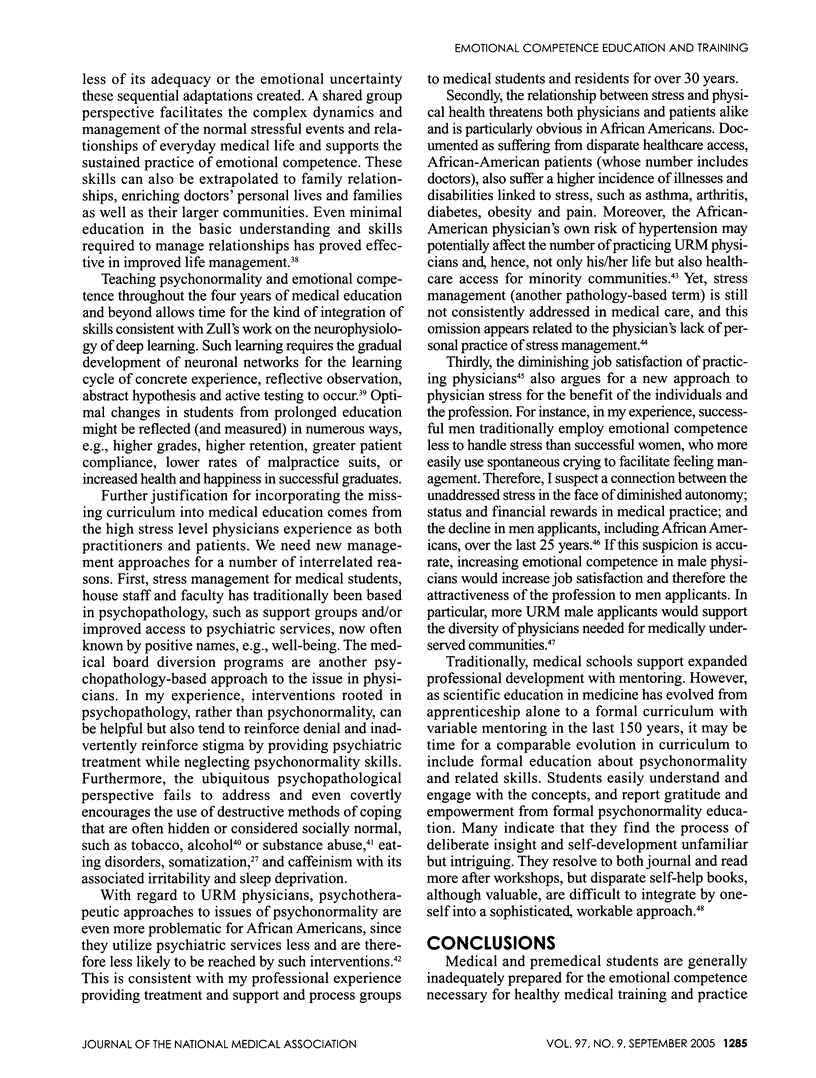
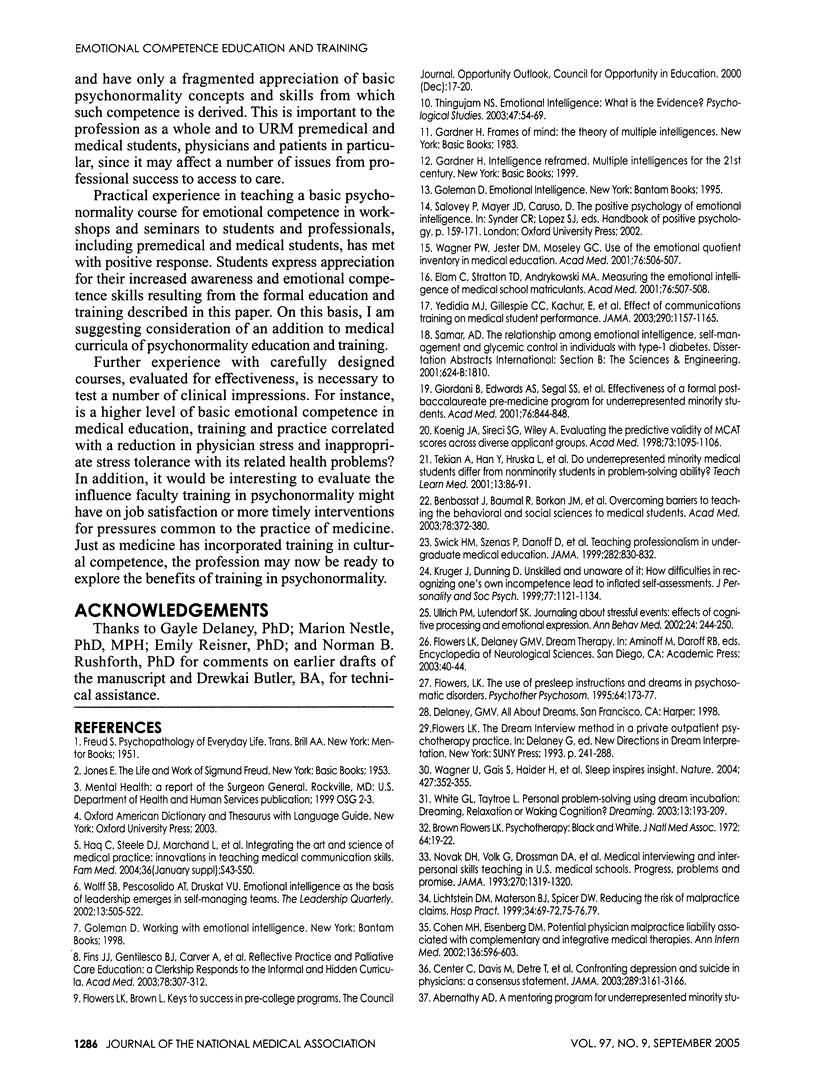
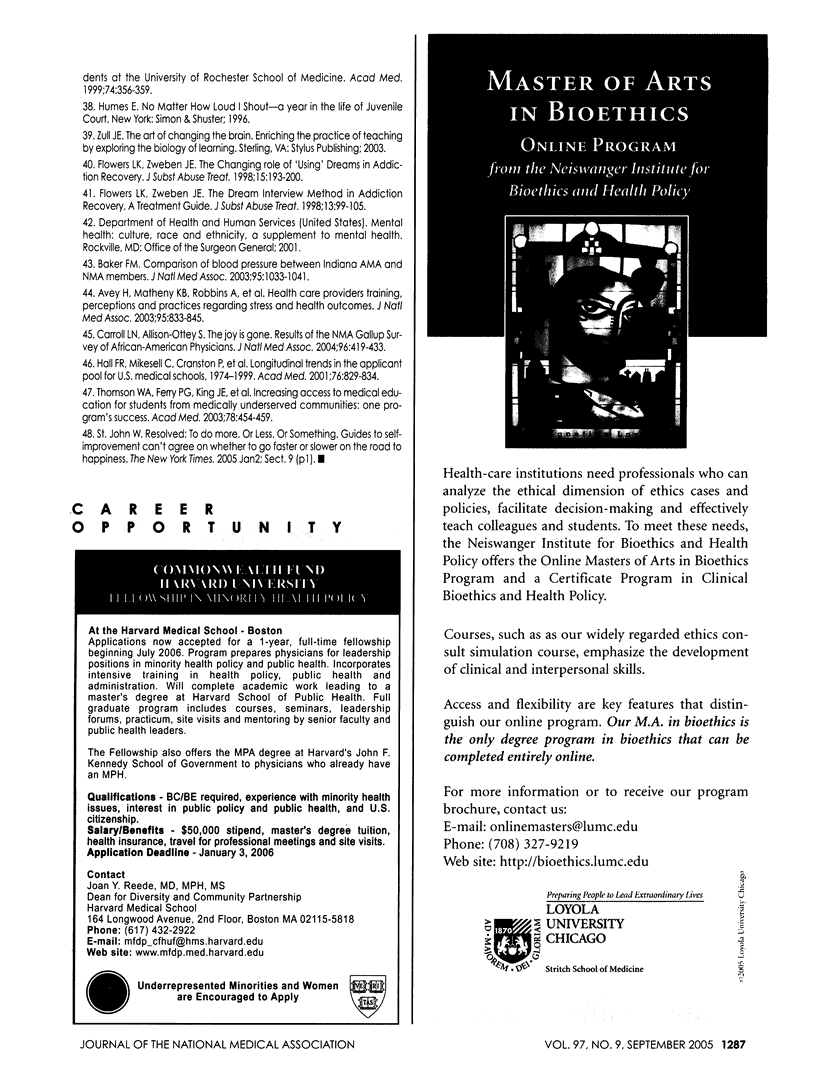
Selected References
These references are in PubMed. This may not be the complete list of references from this article.
- Avey Holly, Matheny Kenneth B., Robbins Anna, Jacobson Terry A. Health care providers' training, perceptions, and practices regarding stress and health outcomes. J Natl Med Assoc. 2003 Sep;95(9):833, 836-45. [PMC free article] [PubMed] [Google Scholar]
- Baker F. M. Comparison of blood pressure between Indiana AMA and NMA members. J Natl Med Assoc. 2003 Nov;95(11):1033–1041. [PMC free article] [PubMed] [Google Scholar]
- Benbassat Jochanan, Baumal Reuben, Borkan Jeffrey M., Ber Rosalie. Overcoming barriers to teaching the behavioral and social sciences to medical students. Acad Med. 2003 Apr;78(4):372–380. doi: 10.1097/00001888-200304000-00009. [DOI] [PubMed] [Google Scholar]
- Carroll L. Natalie, Allison-Ottey Sharon. The joy is gone--results of the NMA/Gallup Survey of African-American physicians. J Natl Med Assoc. 2004 Apr;96(4):419–433. [PMC free article] [PubMed] [Google Scholar]
- Center Claudia, Davis Miriam, Detre Thomas, Ford Daniel E., Hansbrough Wendy, Hendin Herbert, Laszlo John, Litts David A., Mann John, Mansky Peter A. Confronting depression and suicide in physicians: a consensus statement. JAMA. 2003 Jun 18;289(23):3161–3166. doi: 10.1001/jama.289.23.3161. [DOI] [PubMed] [Google Scholar]
- Cohen Michael H., Eisenberg David M. Potential physician malpractice liability associated with complementary and integrative medical therapies. Ann Intern Med. 2002 Apr 16;136(8):596–603. doi: 10.7326/0003-4819-136-8-200204160-00009. [DOI] [PubMed] [Google Scholar]
- Elam C., Stratton T. D., Andrykowski M. A. Measuring the emotional intelligence of medical school matriculants. Acad Med. 2001 May;76(5):507–508. doi: 10.1097/00001888-200105000-00036. [DOI] [PubMed] [Google Scholar]
- Fins Joseph J., Gentilesco Bethany J., Carver Alan, Lister Philip, Acres Cathleen A., Payne Richard, Storey-Johnson Carol. Reflective practice and palliative care education: a clerkship responds to the informal and hidden curricula. Acad Med. 2003 Mar;78(3):307–312. doi: 10.1097/00001888-200303000-00015. [DOI] [PubMed] [Google Scholar]
- Flowers L. K. Psychotherapy: black and white. J Natl Med Assoc. 1972 Jan;64(1):19–22. [PMC free article] [PubMed] [Google Scholar]
- Flowers L. K. The use of presleep instructions and dreams in psychosomatic disorders. Psychother Psychosom. 1995;64(3-4):173–177. doi: 10.1159/000289008. [DOI] [PubMed] [Google Scholar]
- Flowers L. K., Zweben J. E. The changing role of "using" dreams in addiction recovery. J Subst Abuse Treat. 1998 May-Jun;15(3):193–200. doi: 10.1016/s0740-5472(97)00188-8. [DOI] [PubMed] [Google Scholar]
- Flowers L. K., Zweben J. E. The dream interview method in addiction recovery. A treatment guide. J Subst Abuse Treat. 1996 Mar-Apr;13(2):99–105. doi: 10.1016/0740-5472(96)00033-5. [DOI] [PubMed] [Google Scholar]
- Giordani B., Edwards A. S., Segal S. S., Gillum L. H., Lindsay A., Johnson N. Effectiveness of a formal post-baccalaureate pre-medicine program for underrepresented minority students. Acad Med. 2001 Aug;76(8):844–848. doi: 10.1097/00001888-200108000-00020. [DOI] [PubMed] [Google Scholar]
- Hall F. R., Mikesell C., Cranston P., Julian E., Elam C. Longitudinal trends in the applicant pool for U.S. medical schools, 1974--1999. Acad Med. 2001 Aug;76(8):829–834. doi: 10.1097/00001888-200108000-00017. [DOI] [PubMed] [Google Scholar]
- Haq Cynthia, Steele David J., Marchand Lucille, Seibert Christine, Brody David. Integrating the art and science of medical practice: innovations in teaching medical communication skills. Fam Med. 2004 Jan;36 (Suppl):S43–S50. [PubMed] [Google Scholar]
- Koenig J. A., Sireci S. G., Wiley A. Evaluating the predictive validity of MCAT scores across diverse applicant groups. Acad Med. 1998 Oct;73(10):1095–1106. doi: 10.1097/00001888-199810000-00021. [DOI] [PubMed] [Google Scholar]
- Kruger J., Dunning D. Unskilled and unaware of it: how difficulties in recognizing one's own incompetence lead to inflated self-assessments. J Pers Soc Psychol. 1999 Dec;77(6):1121–1134. doi: 10.1037//0022-3514.77.6.1121. [DOI] [PubMed] [Google Scholar]
- Lichtstein D. M., Materson B. J., Spicer D. W. Reducing the risk of malpractice claims. Hosp Pract (1995) 1999 Jul 15;34(7):69-72, 75-6, 79. doi: 10.3810/hp.1999.07.152. [DOI] [PubMed] [Google Scholar]
- Swick H. M., Szenas P., Danoff D., Whitcomb M. E. Teaching professionalism in undergraduate medical education. JAMA. 1999 Sep 1;282(9):830–832. doi: 10.1001/jama.282.9.830. [DOI] [PubMed] [Google Scholar]
- Tekian A., Han Y., Hruska L., Krainik A. J. Do underrepresented minority medical students differ from non-minority students in problem-solving ability? Teach Learn Med. 2001 Spring;13(2):86–91. doi: 10.1207/S15328015TLM1302_3. [DOI] [PubMed] [Google Scholar]
- Thomson William A., Ferry Pamela G., King Jason E., Martinez-Wedig Cindy, Michael Lloyd H. Increasing access to medical education for students from medically underserved communities: one program's success. Acad Med. 2003 May;78(5):454–459. doi: 10.1097/00001888-200305000-00006. [DOI] [PubMed] [Google Scholar]
- Ullrich Philip M., Lutgendorf Susan K. Journaling about stressful events: effects of cognitive processing and emotional expression. Ann Behav Med. 2002 Summer;24(3):244–250. doi: 10.1207/S15324796ABM2403_10. [DOI] [PubMed] [Google Scholar]
- Wagner P. J., Jester D. M., Moseley G. C. Use of the Emotional Quotient Inventory in medical education. Acad Med. 2001 May;76(5):506–507. doi: 10.1097/00001888-200105000-00035. [DOI] [PubMed] [Google Scholar]
- Wagner Ullrich, Gais Steffen, Haider Hilde, Verleger Rolf, Born Jan. Sleep inspires insight. Nature. 2004 Jan 22;427(6972):352–355. doi: 10.1038/nature02223. [DOI] [PubMed] [Google Scholar]
- Yedidia Michael J., Gillespie Colleen C., Kachur Elizabeth, Schwartz Mark D., Ockene Judith, Chepaitis Amy E., Snyder Clint W., Lazare Aaron, Lipkin Mack., Jr Effect of communications training on medical student performance. JAMA. 2003 Sep 3;290(9):1157–1165. doi: 10.1001/jama.290.9.1157. [DOI] [PubMed] [Google Scholar]


